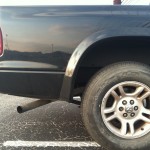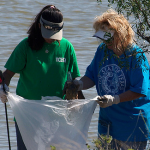Toxic Legacy: 30 Years Later, A Superfund Site Still a Threat

Dave Fehling/StateImpact Texas
Located in Galveston County, it was disposal site for millions of gallons of petrochemical waste
It’s the summer vacation season and on the way to Galveston, thousands of beach-goers drive right past it. It’s a 12 acre field that lies along the east side of I-45 right before you head over the causeway to Galveston Island. It’s doubtful many of the vacationers stop to look, but if they did, they might see a stone marker. It’s an historical marker, of sorts. In big letters it proclaims what is just the other side of a barbed wire-topped chain-link fence: the MOTCO FEDERAL SUPERFUND SITE.
It’s one of over 150 polluted Superfund sites in Texas. Some are under control of the Texas Commission on Environmental Quality. Many of the worst are managed by the U.S. Environmental Protection Agency.

Dave Fehling/StateImpact Texas
"Recovery well" used to pump out polluted groundwater
Congress created the federal Superfund program in 1980, just 10 years after President Richard Nixon established the EPA by executive order. Then as now, there was a debate over who was better to deal with polluters.
Texas vs. EPA
“That’s a very long-running debate. At the time, there were some strong proponents who thought Texas’s legal system, while it wasn’t perfect, could have gotten the job done,” said Tracy Hester, a professor and the University of Houston Law Center and who in private practice has represented companies involved in Superfund sites, including the MOTCO site.
“I think the general consensus that the Superfund program addressed was what at the time was a very serious political and environmental need which was the perception there were a lot of abandoned sites that the law just didn’t have effective mechanisms to address,” Hester told StateImpact.
In Texas, the MOTCO site offers an insight into how those sites came to be and why decades later, some still pose a threat.
Millions of Gallons of Waste
The site began in the 1960’s as a state-permitted disposal for petrochemical wastes from the nearby refineries. For several years, millions of gallons of toxic waste flowed into seven un-lined pits. In 1968, the stench from the toxic brew was so bad the City of La Marque shutdown the operation. In the 1970’s, the site changed ownership with one participant being a Minnesota Company called MOTCO which planned to recycle the waste. But the project was eventually abandoned and went bankrupt.
And so in 1981, the EPA stepped in to clean up a monumental mess.
According to decades-old documents, the EPA in 1982 ranked the MOTCO site as the most hazardous Superfund site in Texas. What the EPA found sounds bad, even if you’re not a chemist. From a 1985 report:
Treatment of up to 15 million gallons of water is expected to be required during the cleanup. Under the water, there exists seven million gallons of organic liquids of which five million gallons will require disposal in accordance with the Toxic Substances Control Act (TSCA) due to the presence of (PCBs). Under the organic liquids, approximately 18,000 cubic yards of sludges and tars are present. Under the sludges and tars are an estimated 45,000 cubic yards of highly contaminated soil.

Dave Fehling/StateImpact Texas
Dubious distinction: marker commemorates MOTCO site
Cleaning it all up took years. The historical marker reads “remediation complete 1997”. But that’s misleading. Polluted water from shallow aquifers is still being pumped from under the site and apparently being treated at a facility built inside the fence line. Dozens of other wells in and around the site are used to track a plume of pollution that remains underground. There was concern over a threat to drinking water. An EPA investigation in 1984 found minute amounts of contamination in what was called a “potential drinking water acquifer” directly below the site.
The latest EPA updated report said the underground plume has now migrated 300 feet off the property. A water well used by the Galveston County Municipal Utility District #12 is a quarter mile away from the site according to John Mercer, the district’s engineer.
‘We tested for everything’
Mercer told StateImpact the well is used infrequently, mostly during peak demand times in the summer and on holidays. The water goes to people who live in two waterfront developments across I-45 from the Superfund site. Mercer said the well water comes from 800 feet below ground whereas the plume, he said, is at 100 feet.
“We tested for everything and found nothing,” Mercer said.
The EPA, which would not provide anyone for StateImpact to interview for this story, said in its latest report on the MOTCO site that the migration of the underground pollution and the potential for human exposure is “under control” but needed increased monitoring.
One resident who lives in the the waterfront development nearby said the site is of little concern but she and her family don’t drink the water. Identifying herself as Terry, she said any possible chemical contamination from the site was just one of many concerns she has about the water. Otherwise, she said she gives the Superfund site hardly any thought at all.
“I’m not thinking about it being close by. It just didn’t really snap at the time (when buying the house),” she said.
________________________________________________________________________________________
StateImpact Texas intern David Barer created an interactive map of the EPA Superfund sites in Texas below. You can click on each site to learn more about the cleanup there. Each place has a link to a detailed EPA report on the Superfund site. The sites are color-coded:
Green: Former superfund. Site has been cleaned and removed from the list of Superfund sites
Yellow: Future superfund site. The site has been proposed for the superfund list but studies are not complete and the site has not become a superfund site yet.
Red: Current superfund site.
View Texas Superfund Sites in a larger map


